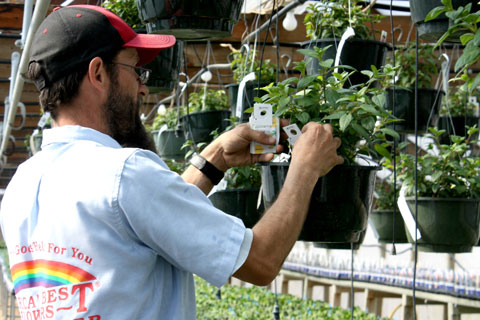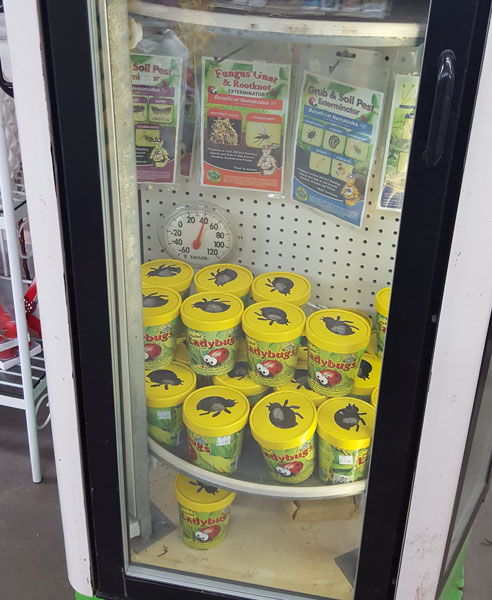4/1/2018
The Benefits of Talking About Beneficials
Jennifer Polanz
In the past, the only time some customers considered insects was when they were perusing the aisles looking for something to kill them in their garden. Today, more consumers are savvy to the fact that many bugs are beneficial to their gardens. However, it still might come as a shock to them to see insects wandering all over the leaves of a plant in the garden center.
That’s exactly what happens, though, at many garden centers across the country that use an Integrated Pest Management (IPM) approach to keeping the nasty pests away. Part of an IPM program includes using beneficial insects on the plants, like at Natureworks, a garden center in Northford, Connecticut, which has been around for 35 years.
“We are an organic garden center, so beneficial insects are everywhere,” says Owner Nancy DuBrule-Clemente, who was in the middle of cleanup from yet another winter storm when she replied for this story. “But our main thing is that we have them in our demo gardens and in our nursery yard naturally.”
Some of those natural predators include ladybugs (prey on whiteflies and aphids), lacewings (the larvae feed on many pests), syrphid flies—also known as hover flies or flower flies (the larvae eat aphids)—praying mantis (caterpillars, moths, beetles and crickets), spiders (prey on a wide range of pests) and many others. Some can be sold in the garden center, while others can be used for pest control, showing customers how efficient they really can be.
 America’s Best Flowers in Madison, Wisconsin, uses an IPM program on its almost 2 acres under cover, which double as both growing and retail space. They use a wide range of beneficials, but General Manager Betty Bless says they use beneficial nematodes the most, along with sachets from Koppert Biological and Biobest in the hanging baskets.
America’s Best Flowers in Madison, Wisconsin, uses an IPM program on its almost 2 acres under cover, which double as both growing and retail space. They use a wide range of beneficials, but General Manager Betty Bless says they use beneficial nematodes the most, along with sachets from Koppert Biological and Biobest in the hanging baskets.
“The only indication we’re doing biologicals (to customers) are the yellow and blue monitor cards, and we have various stations throughout with little plastic clamshells and condiment-type containers that have the biologicals in them,” she says, adding customers notice those and the sachets. “They will say, ‘Oh, what’s that?” It gives you the opportunity to explain what you’re trying to do.”
Pictured: Steve Jones applies beneficial nematodes and scouts for pests at America’s Best Flowers in Madison, Wisconsin.
Stocking the Good Bugs
There are benefits to carrying beneficial insects, but they’re much trickier to stock and maintain than, say, the display of gardening gloves. The three typical beneficials garden centers can carry are lady beetles (ladybugs), praying mantis egg cases and beneficial nematodes. The key to success with the lady beetles and nematodes is to keep them refrigerated, says Karey Windbiel-Rojas, associate director for Urban and Community IPM with the University of California Statewide Integrated Pest Management Program.
“The main issue is their freshness and how they are stored,” she notes specifically about the lady beetles. “This is something we’ve found in California in the last decade or more. Stores were often not keeping them refrigerated, so a whole pint-sized container of lady beetles held at room temperature are very active and half are dead once the customers release them.”
 It goes back to how they’re collected, which is while they’re overwintering in a state of estivation (similar to hibernation in mammals). The distributors collect them and refrigerate them to keep them in a state of dormancy, so the stores need to do the same. If you do sell lady beetles, Karey also recommends including a care-and-release sheet for customers who purchase them. Lady beetles should be refrigerated until their release, which should happen at dusk at the base of a plant that has aphids on it. She recommends spraying a sugar and water solution to give the beetles a little nourishment, which will hopefully keep them around longer.
It goes back to how they’re collected, which is while they’re overwintering in a state of estivation (similar to hibernation in mammals). The distributors collect them and refrigerate them to keep them in a state of dormancy, so the stores need to do the same. If you do sell lady beetles, Karey also recommends including a care-and-release sheet for customers who purchase them. Lady beetles should be refrigerated until their release, which should happen at dusk at the base of a plant that has aphids on it. She recommends spraying a sugar and water solution to give the beetles a little nourishment, which will hopefully keep them around longer.
“The adults will eat some aphids, but at this stage they’re really looking to mate and lay their eggs,” she says, adding many will fly away, but the ones that stay and mate will lay their eggs near a food source. The developing beetle larvae can’t fly and this is the stage that will stay to eat more aphids. Additionally, Karey says stores should have a display of what the lady beetle larvae look like, so customers don’t attempt to kill them, since they look markedly different than the adult lady beetles.
Storage can be an issue, with lady beetles surviving for one to two months in refrigeration and nematodes lasting about a month or even less. Some distributors of beneficials will provide cards to retailers to sell for other beneficial species against pests such as aphids, whiteflies and mites. The customer then sends a certificate to the distributor and receives the insects in the mail. Also, it’s important to note, beneficial insects will only hang around if there’s something to eat, so they cannot be released as a preventative measure.
Pictured: Green Thumb Nursery in Lake Forest properly refrigerated ladybugs during my visit back in 2016.
Setting a Good Example
Part of selling or using beneficial insects in the retail setting is educating customers 1) so they are not afraid of the bugs and 2) so they understand their role in the ecology of a yard and flower bed. It changes the dialog salespeople have with customers when beneficial insects are involved.
“We talk about balance,” Nancy says, adding they sell ladybugs, lacewings, praying mantis and beneficial nematodes at Natureworks. “We don’t sell any organic pest control product without knowing what the pest is or the life cycle. We share this with our customers. They love the fact that we care so much.”
Sharing is caring and there are many ways for retailers to gain the knowledge to share. One great resource for local beneficial insects is your state extension and university researchers, many of whom already work with growers on IPM programs. Another is the distributors themselves. Betty at America’s Best Flowers says they’ve received excellent support from the vendors who supply their beneficials.
This manner of selling does take more time, so it’s important to have identification charts for what beneficial insects look like all through their life cycle, as well as what they do, so customers can make informed choices on the best control methods in case a salesperson isn’t around to help. An ID section on a garden center app also would be a great way to educate customers.
Betty says using the beneficials and being knowledgeable about them changes their dialog when it comes to selling products like pesticides. They carry a complete line of Bonide products, many of which are naturally based.
“We do try to encourage our customers to be really diligent about pesticide usage,” Betty says. “When a customer comes in and says, ‘Hey, I have this bug,” we do teach our staff to qualify each customer as to what is the level of that bug, what is the damage and is it really necessary to use a pesticide.” She also stresses teaching proper application, so whatever product is used doesn’t impact beneficial insects like butterflies and bees.
Nancy sends information out in the weekly e-newsletter, as well as educates customers in the store and through classes and workshops. Just recently, Natureworks held a day-long workshops on a variety of topics, including “Creating Balance: Less sprays, less inputs, more flowers, more food.” In it, Nancy covers how to scout for pests, how timing of plantings makes a difference in pest populations and how to encourage insect populations to do the work for you, as well as cultural techniques to reduce insects and diseases naturally.
What’s Beneficial?
Sometimes the conversation is about more than one aspect of insects. For example, in an IPM program, we’re looking mainly at predatory insects eliminating the “bad bugs” over time. But beneficial can mean lots of different things to the consumer and it’s an opportunity to talk about insects as a whole, both in terms of pest control and in terms of pollination. To that end, many garden centers are already starting the conversation by talking about Monarch butterflies and native bees, and how to build habitats to help both of those populations thrive. Nancy says raising 1,000 Monarchs from eggs and caterpillars collected from the asclepias in the organic demo gardens last year showed customers that everything is connected.
“That totally opened up the conversation with all that came in because any unnatural product from organic sprays, scented paper towels in the raising boxes, soaps or hand creams with artificial scents or ingredients would cause the caterpillars to go into convulsions and die,” she says.
Betty says they’re doing more education in the garden center about pollinators, too, including more events this summer to help customers join the Million Pollinator Challenge.
“We’ve definitely seen more of an interest in how to save the pollinators and in pollinator conservation,” she notes. “People are starting to catch on that it’s not just the Monarchs in danger, but it’s the bees and other pollinators like bats.”
A More Receptive Customer
Nancy has been at this for quite a while, so her customers are well informed at this point. But she says it’s been getting easier over the years as customer feelings shift.
“We have always been organic, so we have been talking like this for 35 years,” she notes. “What’s nice is that now we have a much more receptive audience.”
Betty agrees and says it’s up to the garden centers and greenhouse growers to keep educating the public on the benefits of these helpful insects.
“We think it does have to come from companies like us to educate, and other garden centers and greenhouses to know and realize there are alternatives,” she says. “As a company we want people to treat the Earth better and we’re trying to set that example.”
Karey says retailers, too, are becoming more receptive to learning about and carrying beneficial insects. In the past 10 years, she’s seen an increase in retailers carrying more lady beetles and beneficial nematodes, with some jumping in with praying mantis egg cases, too.
“The main thing we try to impart to retailers is they should try and understand the product and the best way to handle it once the consumer takes it home,” she adds. “If employees can educate the customer at the point-of-purchase on how you care for and release them, the customer will have better efficacy and a better experience with the biological control agents.
“And that will both make the product work better for the intended purpose and give the store better credibility, and the customer will be more likely to return.” GP